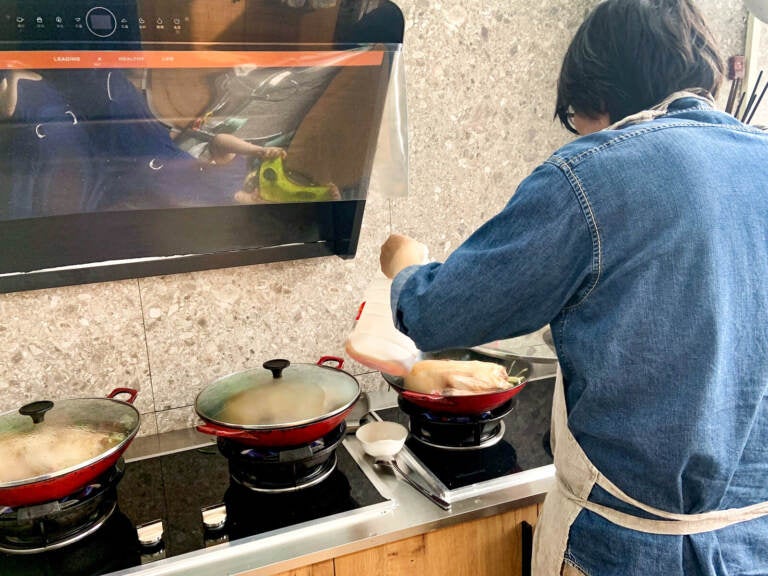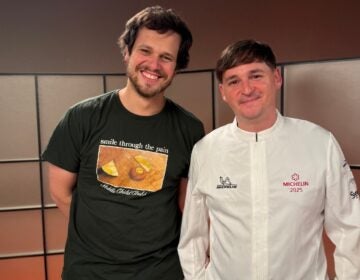The secrets of China’s ‘secret sauce’

Chef Peter — he doesn't want his full name used because he wants to keep his restaurant out of the limelight — prepares duck, which will be finished off with his special Lu sauce (with soy sauce, ginger, garlic and a special ingredient donated by his late mother). (Aowen Cao/NPR)
Chef Peter begins his workday each afternoon by mixing together a fragrant broth of garlic, ginger, soy sauce, sugar and a boatload of spices.
Then he carefully unwraps a plastic bag with his secret ingredient: a sauce that is 40 years old.
“This is just one small element to the dish, but it is crucial to the overall taste,” says Peter.
The sauce is called Lu (pronounced “loo”), and virtually every Chinese regional cuisine uses some variation of it. Lu sauce originally denoted salted water used as a marinade for meat that’s boiled, then served cold, and for vegetables. Nowadays it’s made out of a base of salty liquid, such as soy sauce, with sugar and a mix of spices. And it’s not just a marinade — it’s also used to finish the dish once it’s cooked.
Lu is the secret sauce at the heart of many Chinese family cuisines. To Peter, his Lu sauce is also a heritage from his beloved mother.
“Every time I cook using the Lu sauce, I feel surefooted. I feel I am closer to my mother’s taste,” says Peter. He learned how to cook from his mother, who often traded cooking tips with him after he moved from his native Shanghai to work in northern China.
During one of his last visits home in 2015, before his mother passed away, she gave him some of her Lu sauce to take to Beijing with him, so he could feel closer to home.
An ancient sauce that’s built around salt
Lu sauce originally denoted salted water used as a marinade for meat that’s boiled, then served cold, and for vegetables.
“Salt is the core of Lu sauce, even more important than spices. Spices can add fragrance or remove some smells, but it is the salt that is crucial to the flavor,” says Cao Yu, a food writer and historian at Jinan University.
The earliest preserved recipes for making Lu date back to Qimin Yaoshu, an ancient Chinese agricultural text written in the 5th century: “Mix together 160 liters of water and three liters of salt, then boil it to make the Lu.”
Cao believes the Lu sauce we know today emerged around the Ming dynasty more than seven centuries ago, when privatized agricultural businesses and food markets began popping up in China. To attract customers, these food vendors began introducing new flavors to the sauce by adding spices as well as soy sauce for color, then using the sauce to season cooked meats and vegetables that were sold cold for takeaway,
In the centuries since, Lu has diversified, taking on the characteristics of each of China’s regional cuisines. For example, in spicy Sichuan province, fragrant peppercorn and star anise are infused into Lu to add flavor and intensity.
Some Lu is even alcoholic: Zao Lu is a light marinade made from the fermented glutinous rice mash leftover from brewing Chinese yellow wine. Zao Lu is used across south-eastern China to season vegetables.
His sauce came straight from his mother
The Lu sauce chef Peter uses in his restaurant comes from an unbroken chain of sauces dating back to that first batch his mother made in the 1980s.
Today, he still maintains that original Lu sauce by giving it new “nutrients” each day – a fresh infusion of spices and meat, which is boiled in the sauce to enrich it.
“You have to raise an old Lu sauce, like raising a child,” Peter muses.
Peter always saves the remainder of each Lu batch and uses the old sauce to start the next, new batch of sauce. It is a bit like sourdough, where the last batch seeds the next batch, and the flavor intensifies over the years.
“Think about it: my duck Lu sauce was begun by my mother in the 1980s, so in one dish of Lu braised duck, you are eating the essence of at least seven or eight thousand ducks that have passed through it,” he says. “My sauce is really an accumulation of time.”
As a result, Peter does not like to receive clients who are in a rush. Like an old wine, he says, you must ruminate on the Lu sauce carefully to appreciate its rich aftertaste: fatty, sweet and salty.
After four hours of slow simmering, Peter’s sweet, Shanghai-style Lu has cooked down to a dark, thick soup. Peter reduces it further until he becomes a molasses-like syrup.
The intense, old Lu sauce has made Peter’s restaurant — tucked away in an unmarked residential apartment –– a well-hidden gem in Beijing, advertised through word of mouth only. Peter expressly forbids us from using his full name or from mentioning his restaurant in this piece.
“We have a saying in Chinese: fame brings trouble. This restaurant is my playground. I do not want too many people to come.”




